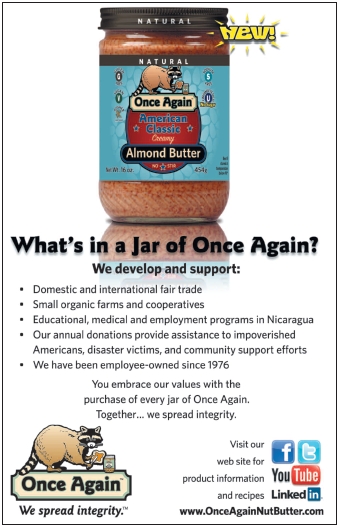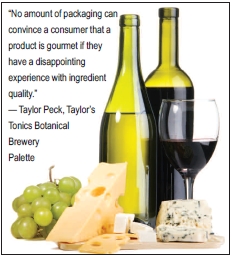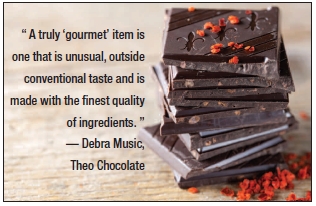One in five shoppers seek out gourmet foods when grocery shopping (1). Though you may not see yourself as a gourmet store per se, it’s likely that shoppers see your products as upscale and expect you to offer high-end foods and beverages.
Closing the High-End Sale
Total U.S. retail sales of gourmet/premium foods and beverages through all retail channels reached $67.1 billion in 2009. This figure marks a 3.7% increase over 2008 sales and an 8.7% compound annual growth rate from 2005 to 2009 (1).
One factor that could be driving sales in the gourmet market—even during a down economy—is the popularity of home cooking shows. These programs have piqued Americans’ interest in preparing gourmet meals from scratch. To meet this need, those who sell natural/organic foods must stock certain staples and help shoppers distinguish “gourmet” from “non-gourmet” foods. The term “gourmet” means something slightly different to each individual, but according to Debra Music, vice president marketing and sales at Theo Chocolate, Seattle, WA, “A truly ‘gourmet’ item is one that is unusual, outside conventional taste and is made with the finest quality of ingredients.”
There are also various tiers of “gourmet,” says Bill Higley, CEO of Penny Pop’s Surprise, Portland, OR. “Gourmet is very good. Gourmand is supposed to be even better. And, epicurean is the top of the line,” he explains.
For Higley, the ingredient blend is what makes a product truly high end. “My idea of epicurean and gourmet is the very delicate blend of tastes to create something new,” he says. “Just the tiniest little bit of a spice can make the difference. It’s perfection or it’s not.”
An example is his firm’s olive–canola oils, which are infused with garlic, cinnamon and chiles, but the taste of an individual ingredient doesn’t overpower the final oil. Higley states, “It’s a very delicate blend and balance, and that’s the way it is for any gourmet food.”
But, the terms “gourmet” and “epicurean” have become marketing gimmicks to some companies. Thus, it’s up to retailers to be discriminating about their specialty food and beverage offerings, agreeing to sell only products that are truly living up to their idea of gourmet status. This means going beyond the look of a product. “Ingredient quality is increasingly requisite of gourmet items, while inversely, lavish packaging is decreasingly important,” says Taylor Peck, cofounder/CEO of botanical soda maker Taylor’s Tonics Botanical Brewery, Santa Cruz, CA. This wasn’t always the case, he states, as 20 years ago, a fancy emblem was all an item needed to be considered gourmet.
Part of the reason for the changing focus from “superficial gourmet” to “gourmet ingredients” is that consumers are buying such items in different places than they were a couple decades ago. “A household’s shopping pattern today may include an artisan bakery, a farmers’ market, various upscale shops, and a natural retailer,” Peck states. “Consumers know that gourmet products can look great and come in a charming bottle, sensible box or arrive farm fresh with no wrapper at all.”
To put it simply, no amount of fancy packaging can transform an item from “okay” to “gourmet.”
Examining ingredients is especially important for natural products retailers, since their clientele is also highly concerned about health. “Retailers often don’t scrutinize ingredients carefully enough, and this is unfortunate as consumers typically rely on their favorite retailer to do so,” states Music. “Consumers will believe that a retailer’s espoused values are represented in every single product on their shelves and this is often not the case.”
The shopping list. So, aside from quality, retailers can help close the sale on gourmet foods if they stock a few staple items that are often included in gourmet meals. Kristy Klug, marketing communications specialist for DCI Cheese Company (maker of Organic Creamery cheeses), Richfield, WI, starts the shopping list with cheeses like Havarti, sharp cheddar, crumbled feta, gorgonzola, blue, shredded parmesan and asiago. Organic, handcrafted offerings of these cheeses and other dairy items like butter may help establish your store as a go-to source for gourmet staples.
 These staples support the trend of gourmet comfort foods like grilled cheese and macaroni and cheese, “which were traditionally thought of as inexpensive meal options and hardly fell into the category of gourmet,” observes Simcha Weinstein, director of marketing at Albert’s Organics, Bridgeport, NJ. Gourmet shoppers aren’t interested in the old-school, prepackaged variety, and are making time-honored favorites with upscale cheeses. He adds, “Even grilled cheese sandwiches, which used to include white bread, American cheese slices and margarine are now being made using a wide variety of specialty cheeses and whole grain breads.”
These staples support the trend of gourmet comfort foods like grilled cheese and macaroni and cheese, “which were traditionally thought of as inexpensive meal options and hardly fell into the category of gourmet,” observes Simcha Weinstein, director of marketing at Albert’s Organics, Bridgeport, NJ. Gourmet shoppers aren’t interested in the old-school, prepackaged variety, and are making time-honored favorites with upscale cheeses. He adds, “Even grilled cheese sandwiches, which used to include white bread, American cheese slices and margarine are now being made using a wide variety of specialty cheeses and whole grain breads.”
Next on the list is produce. While they are handy for everyday cooking, canned and frozen fruits and vegetables may not cut it for someone taking the time to prepare a gourmet meal. For these folks, Weinstein recommends going with local produce. “Even though we think of gourmet items as needing to be imported, local and regional growers and producers are well aware of this trend and actually embrace it as it means a wider market for them with the ability to produce foods that attract not only a strong price, but a very loyal following,” he states. And with locally grown produce, you can sell shoppers on the freshness and full flavors.
The same mentality goes for cooking oils, another important staple to carry. Whether they are imported olive oils or new-to-market green tea oil (from Bien Padre Foods), having the right gourmet oil on hand will make or break a dish.
Last, keep your eye on the entrance of ethnic foods into the gourmet category. Weinstein believes that Middle Eastern and Indian foods are particularly hot. These foods are ones for which people used to visit restaurants. “Now, more and more we are seeing an uptick in these meals being prepared at home,” he states. Thus, international grains like couscous, risotto and quinoa may be smart to stock.
No matter which products you choose, however, Higley reminds us that one of the most important things a retailer can do is to taste the product. While this may sound elementary, many stores are too busy to try new products and make assumptions without tasting them. “If you don’t taste the product, you won’t understand what you are selling,” he says.
Young foodies. Don’t be surprised if 20-somethings become some of your most enthusiastic gourmet food/beverage clientele. They are increasingly interested in trying high-end, gourmet meals.
Retailers, if you aren’t used to marketing to this younger crowd, gourmet food manufacturers say the key is to make them feel at home. States Klug, “When a consumer is comfortable with a product, they’re more apt to buy it.”
Her company has in-store signs available with quick-response (QR) codes that are especially suitable for younger adults, she feels. “Consumers with smart phones can snap a photo of the QR code and their phone will automatically redirect them to a microsite specifically developed for the corresponding product,” she states, adding that information about beverage pairings, serving suggestions, recipes and coupons are provided. “This technology is in its infancy right now and we have the capabilities in place to utilize it for our customers, keeping them on the cutting edge,” she states.
Since younger consumers may be very visual, Caroline Frey of Frey Vineyards, Redwood Valley, CA, recommends spotlighting gourmet foods with themed displays. For example, she envisions Spanish- or Italian-themed displays with corresponding wines and foods. “This could include both local (such as a locally grown vegetable or locally produced sauce or salsa) and imported (cheese for example),” says Frey. “This way a young consumer could plan a whole gourmet meal without having to search all around the store for the necessary ingredients.”
Peck adds that retailers should be sensitive to the fact that young adults may not have the same cash flow as clients with established careers. “To attract younger consumers, price points must remain at reasonable levels,” he states.
One way to get around this is to offer smaller or single-serving sizes, if available from manufacturers, so those on a budget don’t have to spend as much and other clients can sample items of interest without making a huge investment.
Sweetening the Deal
Be they in miniature or oversized form, gourmet sweets like cupcakes, brownies, chocolates and cookies are hot today. Shoppers like to have a little indulgence from time to time, and if they’re going to pamper themselves with gourmet, they may as well treat their sweet tooth, too.
When choosing chocolates to stock, Bahram Shirazi, CEO and Founder of Q.bel Foods, LLC, makers of Q.bel chocolate wafers, Nyack, NY, advises retailers to pay close attention to the cacao content as many shoppers are looking for Dark chocolate with a capital D. Some are even craving intense darks that go up to 60% or 70% dark chocolate.
Interesting textures are also key in the category today. Shirazi uses the example of innovative New England ice cream makers from the 1970s and 1980s that “changed the category forever by recognizing that adding mix-ins enhanced the experience. It added a whole new element of fun to encounter crunchy and chewy bits in the cold, creamy mass,” he states, adding a similar trend is underway in the upscale sweets category. “People are looking for a more rounded sensory experience,” he states.
 Spicy, savory flavors are also sweetening the deal for dessert lovers. Many companies, for instance, are tying together chocolate and spices that give a kick like coconut curry (Theo Chocolate), chai tea (Theo Chocolate, Dagoba), fig/fennel/almond (Theo Chocolate), espresso (Endangered Chocolate, Green&Black), ginger (Chocolove, Green&Black), lemon ginger (Dagoba) and chilies (Chocolove, Dagoba). And, sweet and salty combos are still en vogue.
Spicy, savory flavors are also sweetening the deal for dessert lovers. Many companies, for instance, are tying together chocolate and spices that give a kick like coconut curry (Theo Chocolate), chai tea (Theo Chocolate, Dagoba), fig/fennel/almond (Theo Chocolate), espresso (Endangered Chocolate, Green&Black), ginger (Chocolove, Green&Black), lemon ginger (Dagoba) and chilies (Chocolove, Dagoba). And, sweet and salty combos are still en vogue.
States Music, “In chocolate, I think consumers are open to anything new as long as ultimately it’s really yummy. Chocolate in any way, shape or form is always going to get attention and gain fans.” To prove her point, she teases us with this: “I think we are about to see a fermentation renaissance. We’re working on the perfect pickles-and-chocolate combination right now. . .keep you posted!”
Wine and Dine ‘Em
Wines have an interesting place in the gourmet foods market. Such beverages are associated with vineyards far and wide from France to Australia. While international wines will always have a place in the gourmet market, today’s shoppers may also be looking for something quite different. Wines produced in local vineyards, micro-brewed beers and artisan spirits have piqued consumers’ interest.
Many shoppers are also interested in organic wines, either because they feel they are of a higher-caliber or because they have an allergy to wine’s sulfites. Very small amounts of sulfites naturally develop in wines during the fermentation process, but many winemakers add even more sulfites after this process to make the beverage more shelf-stable and to discourage bacteria and yeast growth. Makers of USDA-certified organic wines don’t take this extra step of adding more sulfates (2).
According to allergist Neil Kao, a spokesperson for the American Academy of Allergy, Asthma & Immunology, about 1% of individuals are allergic to sulfites, and about 4–5% of asthmatics cannot tolerate sulfites (1). Again, recommending certified organic wines may be the best way to meet the needs of this group of clients.
But according to wine expert W. Blake Gray, organic wines can be hard to come by since “most winemakers feel that sulfites are crucial in winemaking” (3). Some winemakers are petitioning the U.S. Department of Agriculture to allow sulfites to be added to organic wines. Many groups, including the Organic Consumers Association, have voiced opposition to this movement. But, Paul Dolan of Mendocino Wine Co., believes this would “encourage more grape growers to be certified organic, meaning the use of fewer herbicides and pesticides in vineyards” (3).
Until the rules change, however, few (if any) large wine producers play in the organic market. Therefore, it’s up to small organic winemakers like Frey Vineyards to fill the void by offering certified organic wine. This manufacturer of 100% organically grown and produced organic wines adds that its products have been made without sulfites for 8,000 years, and believes that making organic wine without sulfites isn’t problematic. “We take this approach because we know that quality fruit and careful attention during fermentation and aging are the only ingredients needed to make great organic wine,” says the company. “Grapes grown in healthy, vital soils contain all the nutrition yeast will need to complete a clean and healthy fermentation. High-quality, organic fruit also provides an abundant supply of naturally occurring phytochemicals (natural plant compounds) that provide rich and complex flavor components. Natural plant chemicals also act as natural preservatives and are beneficial to human health.”
In the end, unique organic wines appeal to the masses, says Caroline Frey, because “they are something fun to be enjoyed and shared with others. These days, people seem to want less ‘stuff’ and more experiences instead. Drinking a unique beverage is a fun experience.”
Get in the spirit. Frey’s point about consumers wanting a unique beverage experience may explain why they are also interested in microbrews.
Adds Dean Phillips, president and CEO of Phillips Distilling Company (which distributes Prairie Organic Vodka and other spirits), Minneapolis, MN, “The joy of discovery and support of authenticity are just two of the great rewards associated with micro-distilled, gourmet spirits.”
According to Phillips, the appeal of such spirits is that “sophisticated consumers increasingly want to know the people, places and stories behind the brands they select and those elements are becoming primary to the decision-making process.” He says gourmet spirits are often microdistilled and hand-bottled, so the end-product “reflects the passion and dedication embodied by their distillers.”
This small-batch production technique, says Peck, “allows producers the freedom to experiment with sophisticated and unique flavors without having to go ‘all in’ or develop for the most simplistic palate.”
Small, local distilleries are opening all around the country, giving shoppers the chance to try something truly special. Peck adds that craft production gives manufacturers the opportunity to bring to market experimental flavors that “may need time to ramp in consumer appeal” or be discovered. This is an area to which stores may turn to discover what could be the next-big selling beers and spirits. Peck believes, “Craft products have paved the way previously for what later becomes mass market acceptable once influencers have determined their market worthiness.”
Some shoppers are even interested in creating their own flavors at home. Phillips adds that home-infusing of spirits can be as simple as adding organic produce to flavor an organic vodka, for instance. “In the summertime, my wife Karin and I slice up an organic cucumber and some fresh mint, place them in a bottle of Prairie Organic Vodka and lay it on its side out of the sunlight for two days. Once the flavor seems right, it’s best to consume it within a couple days or place in the refrigerator to maintain freshness and prevent over-infusing,” he says.
Similar to all segments of the gourmet category, ingredients are important. But, the U.S. Food and Drug Administration and the Federal Tax and Trade Bureau don’t allow nutritional statements on spirits labels, so retailers may still need to ask their manufacturers about specific ingredients in their beverages, says Phillips. He suggests asking manufacturers these questions as a baseline:
1. Which chemicals are used on the grains from which the product is distilled?
2. For sweetened products (e.g., liqueurs), is natural cane or beet sugar used or processed corn syrups?
3. How is the water used in the product treated and filtered?
4. Are flavorings natural or artificial?
5. Are any artificial colorings added?
6. Are any blenders or additives used in the finished product?
Warming Up to Tea and Coffee
Tea and coffee are important aspects of the natural gourmet market. According to Linton Pope from The Red Leopard Tea Co., Woodland Hills, CA, “Organic is the fastest growing category of teas in the United States.” This is key because some growing segments in the tea category are difficult to find as organic. For instance, he says Rooibos is growing in popularity, partly because it is naturally caffeine free and some feel the decaffeination process is not healthy. “Only 20% of Rooibos growers produce organic Rooibos and we are proud to offer our range of USDA-certified Rooibos teas. Our flavors are all organic and created in Germany under very strict conditions,” states Pope.
Pope also notes that Rooibos has very little tannin in it, which “allows for very long steeping times and has none of the traditional bitterness of other teas. In addition, Organic Rooibos has a natural sweetness thereby reducing the need for sweeteners, which is another demand in the marketplace.”
Vera Stavroff, president and CEO of HerbalScience of New Albany, OH, feels that herbal and green teas are popular among shoppers. “There are many driving factors like healthy eating trend, pursuit of a healthy lifestyle and the acknowledgment of a greater responsibility for the quality of one’s own health,” she states, noting the antioxidant benefits of these teas has much research backing and consumers (especially Baby Boomers) are acting upon this knowledge by buying green and herbal tea.
Stavroff believes these health properties are especially important in the high-end tea market. “Consumers are willing to splurge on high-quality herbal teas and other wellness products because they are taking a proactive interest in preventing health problems and are seeking longer, healthier lives,” she states, noting that in some ways, this is what defines a gourmet tea: one that, in addition to being of a high quality, “delivers both wellness and pampering with emphasis on healthy and pleasurable benefits vs. everyday tea is just that…tea.”
According to Anne-Marie Phillips, head of sales and marketing for Choice Organic Teas, Seattle, WA, “wellness” is a great inlet for shoppers to the tea category. “Most tea drinkers in the United States are first introduced to tea for health reasons—to relieve ailments, boost natural functions, to replace coffee, or more recently, as a weight loss aid,” she states, adding that her firm can often tie demand for a type of tea to its support by the media.
Another important component of gourmet teas, says Phillips, is their origins. She states, “They are also sensitive to ethical and sustainable manufacturing practices and certifications such as organic, Fair Trade, environmental packaging, and food safety—all of which are high priorities for Choice Organic Teas.”
The handling and growing of the product is also key for gourmet or specialty coffees. Like tea, these coffees are of a higher quality. They shouldn’t taste bitter or burnt, says José Gaviña, CFO and head of sales for Gaviña Gourmet Coffee. “That comes from coffees that are grown in higher elevations. In our Don Francisco brand, we only use 100% Arabica coffee from regions that are high in the mountains—over 2,000 meters,” he states. The higher elevations create a soil that produces a “much better cup of coffee,” says Gaviña.
He says there are two kinds of coffee: Arabica and Robusta. “The Arabicas are of a higher quality, and they are grown mostly in Central and South America,” says Gaviña. “Robustas are grown mostly in Indonesia, Vietnam and Africa. They are grown in lower altitudes. People use them because they have a much higher yield per tree than the Arabica.” This, of course, means that the Arabicas are typically priced higher than the Robustas. Gaviña says that makers of non-specialty coffees will often blend them together to bring down the price.
Another aspect of specialty coffees is their roasting, which must be done to perfection, says Gaviña. Each coffee responds to roasting differently, and thus requires a different roast level and temperature, he explains. Even coffees from the same country may behave differently. “You can roast quickly, if you want, but that doesn’t give you the proper taste. To have a perfect cup of coffee, you have to take your time and do it the proper way,” says Gaviña. “If you flash roast, you toast the coffee. If you roast too slowly, you are baking it. If you do it right, then you’re roasting the coffee.”
Phillips makes a similar point with respect to tea. She states, “Like any other agricultural crop, the quality of a tea depends on the care and handling through all the stages from the farmer, to the processor, to the blender, to the packer, and finally to the customer,” she states. “As long as you handle your tea with care, you can have an exceptional leaf of tea…whether it is in the form of a full leaf of tea or broken into smaller pieces for use in a tea bag.”
Whether you choose to stock gourmet foods and beverages, one thing is clear: with the right marketing and mixture, these products can help you ring up high-end sales. WF
References
1. Packaged Facts, Gourmet, Specialty and Premium Foods, Beverages and Consumer Trends in the U.S., 8th Edition Sept. 1, 2010.
2. Wine Spectator: Wine & Healthy Living, enewsletter sent Jan. 6, 2011.
3. W.B. Gray, “Why Isn’t More Wine ‘Organic’?” Los Angeles Times, Jan. 06, 2011, http://articles.latimes.com/2011/jan/06/food/la-fo-organic-wine-20110106, accessed March 10, 2010.
Published in WholeFoods Magazine, October 2011











